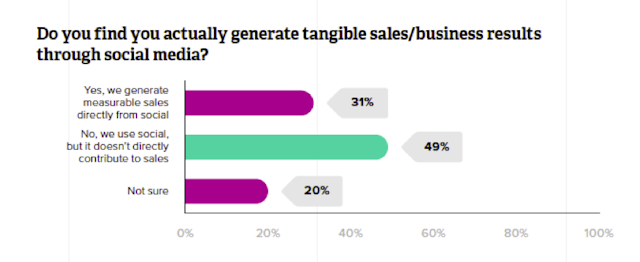Three mistakes to avoid with your social strategy
As a business, you know that social media is an important part of your overall digital marketing strategy - of course you do, it’s 2019. Social media has so much potential; it could drive your sales, increase your ROI and contribute to your lead generation, but yet so many brands use social media yet don’t get tangible results from their activity.

Zazzle Media help marketers to navigate the world of social media with their guide for do's and don't's.

With a well thought-out, effective social media strategy, your platforms like Facebook, Instagram, Twitter and LinkedIn could ultimately drive something different for your brand.
An established social media presence can be that small difference to turn enquiries into conversion. For many, the correct social media strategy is the missing link between their business and the consumers.
But how can you make this work for your business? Social media is rapidly changing and evolving. New algorithms, updates and trends can make it feel difficult to keep up. In order to know what you should be doing, you need to first understand what you should not be doing. Let’s look at the three biggest mistakes you could be making.
1. Cross-platform posting
Each social media platform is designed to serve a different purpose. Something that works on one platform could be catastrophic for another. Think of each platform as a different language what would happen if you tried to speak Spanish to a French native? They wouldn’t understand your point. You need to be completely fluent in various languages, and tailor your narrative to each territory, in order to engage in successful conversation.
When devising the languages, you need to learn to speak, to first look at the natives you want to contact. Your target audience, where are they? Are they a housewife that spends most of their time on Facebook sharing parenting woes and cute pictures of their children baking cookies? Are they a creative student that likes to create colourful, artistic and unusual images on Instagram? Are they a busy professional that likes to quickly scroll through short and sweet tweets on the tube? Are they teenagers who like to spend their evenings watching gaming tutorials on YouTube?
All platforms are not equal and each attract a different type of audience - using personas is the best way to map this out for your brand. The first step is to do some research to find what platforms your audience are spending their time on. Then you need to tailor each post to that specific platform. All the way from the size of any accompanying media, to the length of the caption – it all plays a huge part in the overall strategy.
Understanding different social platforms
To explain, let’s say you were a travel brand - how would you engage people on different platforms?
If you were to post an update on Twitter from your travel brand, you would want to keep your post short, sweet and snappy with a hashtag:
Looking for the ideal holiday resort to kick back and relax? #Dubai has plenty.
You could add in a link to the article on your website – but you will need to be sure to shorten the URL down. Twitter is all about showing who you are, what you do and how that makes up your character in less than 280 characters. Therefore, you want to get your message across clearly.
In comparison, a similar target audience to those on Twitter can be found on LinkedIn. However, how they use the different platforms vary, with the main difference being continuity against immediacy. If you were to post our scenario on LinkedIn you would post something like:
Have you thought about combining your business trip with pleasure? Travelling for work doesn’t have to be a burden, isn’t it about time you booked a leisure trip?
Linked In allows for continued discussions and debates and can be ongoing for days after the original post-date, as opposed to Twitter which is real time with a short lifespan. Linkedin is the place to elaborate on points and expand on your expertise.
While Twitter and LinkedIn are recognised as the more professional websites, Facebook and Instagram are designed to allow people to communicate, share and socialise. However, there are differences in the way you should be posting between even these two social platform. On Facebook you would post a descriptive post such as:
Whether you’re looking for a bustling, contemporary city; or ancient, charming ruins – Egypt has both. Where are your favourite Egyptian destinations?
Facebook’s algorithms are currently based on comments and reactions so emotion provoking and descriptive words are a must, along with open questions, inviting your audience to comment and/or react to reach even more people. You want to create posts and use wording to provoke family and friends to tag each other, share stories and talk about their experiences.
Here is an example of TUI doing just that, an open question inviting reactions, comments, discussions and debates. Therefore, gaining 112 comments and 265 reactions.

However, the platform is under a complete redesign as we speak, so it is really important to keep up to date with the latest features and tweaking your strategy.
Instagram is much more about the image; less words are needed. The most important part of the post would be a stylised image of a holiday destination, lots of colours to grab the eye, and ensuring that the image captures a specific activity or emotion. Instagram’s algorithms are based on interest and recency so it is best to post a variety of topics that target your consumers, as well as regularly.
2. Overselling
Social media directly connects you to your consumer. The quickest and easiest way to disconnect yourself from your audience is to oversell. Pushing products down the throat of your audience is a sure-fire way to turn them off.
Imagine you are taking a cold call from an electricity supplier, as soon as you grasp that the call is a salesperson – your guard is instantly up – because you feel you are a target figure on a whiteboard – not a person. Now, this sales caller could have the greatest deal in the world that could actually save you hundreds of pounds on your electric each year, but chances are you won’t give them the time of the day, or even keep them on the line long enough to hear them out.
Now take this and apply it to your audience, as soon as you present yourself on social media as a salesperson, you will lose the majority of interest from your audience – their wall is up. Instead, you need to connect with them – post engaging and useful content that answers your audience’s pain points. Just enough free content to show you are an industry expert – but not too much, to make them feel as though they want and need more.
You need to firstly gain the respect of your audience, and then sales will come. Think of your social media as the pre-pitch. Use your socials to give your brand a personality. In order to do this, you need to know exactly who you are, what you do, how you can help and what you have to offer. Once you define this, it will be a lot easier to make it shine through in your posts.
Overselling on Instagram
Instagram is a real time visual network, so leverage this. Beautiful photos that capture the audience’s attention will make them want to read the caption. You can forget hyperlinks in captions too: Instagram want to keep their consumers on the app, that is why you can’t add any clickable links in photo captions.
Use this platform you show your products in real-life use, tutorials, behind the scenes even fun and light hearted memes, if it fits your target audience. Create a personality and life on your Instagram and leverage it to capture special moments within your business, and share it with consumers to make them feel connected to you.
According to business.instagram, 500 million users utilise Instagram stories every day – that is half of the one billion monthly Instagram users. Many people are also admitting that they no longer ‘scroll’ on Instagram – they navigate around the platform using stories; this involves clicking through to static Instagram profiles through the links in a story. These are great statistics to leverage, as a story is live content – perfect for new product releases, in the moment videos and behind the scenes shots.
Instagram’s shopping feature allows you subtly tag a product with a description, price and link to take them to directly purchase the product. This is the only place you should be talking about price and product descriptions on Instagram.
An eye catching lifestyle shot of your product in use with a catchy, witty and fun caption is going to engage your consumers. The shopping feature is then there for your consumers – if they are far enough down that funnel, to want to purchase. You are not ramming the sale down their throat, but simply giving the option to buy. There is a big difference, and it is so important to make sure you are getting it right.
Brand collaborations and influencers are another example of how you can strategically use social media, but it is really important to create partnerships with influencers that actually value the content that they receive from you, as well as take authenticity in their feed rather than just ‘plug’ your brand a couple of times.
Here’s an easy ten step guide on how to work with bloggers for your brand. The key thing to consider is building a relationship with your influencers, talk to them in depth about your brand and values. Helping them to understand your business, will help them to create posts that truly represent your business. Aim for brand ambassadors – rather than one off endorsers. Most importantly, you need to trust your influencers – otherwise you could end up with an embarrassing mistake, like this one from Scott Disick:

3. Forget to listen
Are you making the common mistake as a business of using your social media to prove to your consumers how great you are, and how much value you can bring? This can sometimes get in the way of allowing you to listen, listen to what your customer needs to know and want to have.
The first step of listening is interaction. There is so much value in taking the time to respond to consumer comments and messages. This makes them feel as though you are taking the time to understand what is important to them, and in turn – that makes them feel important. This is where a relationship is built on respect and trust between you and your consumers.
There are so many benefits to engaging with your consumers. Most obviously, customer service. Being responsive shows great customer service skills. You should respond to both positive and negative comments, try and work to turn it into a positive.
Many businesses mistakenly still refer to the sales process as a ‘funnel’ – when in actual fact – it is more like a ‘flywheel’. Renewing your inbound strategy and changing this one small aspect could have a massive impact: Instead of putting customers at the bottom of the funnel, you should place them in the centre of your activity. You can keep your ‘flywheel’ moving with ongoing momentum by using social media to respond to queries, questions, reviews and keeping past consumers engaged to create loyal customers that just keep coming back for more.

Additionally, the most important benefit to listening on social media is insight. Knowledge and insight into your most important people – your target audience. This is research you cannot afford to miss. Ultimately, you want to answer all of your customer’s pain points and what better way to learn about your customers’ pain points that to hear directly from those people. Real people, talking about your industry and your business; what better research can you get?
Listening to competitors
You can use social media to listen to what people are saying about your competitors, as well as just you. This can feed into your overall strategy and show you exactly where you fit into the industry. It is a good way to figure out what opportunities there are out there, have a look at the campaigns they are running, events they are doing, what posts are getting lots of engagement for them, and which are not.
You can also pick up on consumer pain points from customer feedback to your competitors. Have a look at both their positive mentions, and negative mentions. If you dig a little deeper and look into how this correlates with product launches and campaigns you can get a good idea of what is working for your target market, and what is not.
By picking up on cracks in your competitor’s strategy it will help you to identify any in your own. Sometimes you can be too involved in your own campaigns and strategy and miss problems and issues that you would see in a competitor. By taking yourself out of your own four walls and into the realms of a competitor, you’ll come back feeling like you have a fresh pair of eyes on your own.
Once you fully understand the ‘do-nots’ of social media, you can take a better perspective when planning your ‘do’s’!
Content by The Drum Network member:

Zazzle Media
We've been illuminating content marketing, since 2009. Matching innovative content with a targeted audience of value is our mission.
Our promise, as it always...

